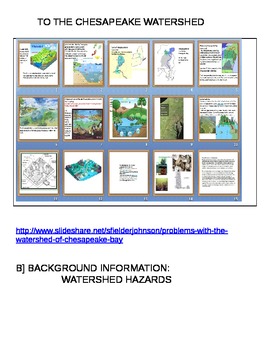Watershed Unit Plan with Lessons on making a working model includes Chesapeake
Suzanne Johnson
9 Followers
Grade Levels
3rd - 5th
Subjects
Resource Type
Standards
CCSS3.MD.A.2
CCSS3.MD.B.3
CCSS4.MD.A.1
CCSS4.MD.A.2
CCSS4.MD.A.3
Formats Included
- Word Document File
Pages
30 pages
Suzanne Johnson
9 Followers
Description
In this unit, students will be introduced to what a watershed is and how it relates to their life. They will read about watersheds and threats to a watershed, they will be introduced to new vocabulary, and they will create a watershed model.
This project based learning experience will involve students creating a model of a watershed. This model will include examples of the threats to watersheds which they have been learning about. It will be a workable model that will allow them to alter the landscape to prevent problems such as erosion and runoff from impervious surfaces and farmland fertilizers. Students will work together to analyze data and determine solutions.
The unit includes an introductory Power Point which teaches about the ecosystem of a watershed, readings and comprehension questions about watershed contaminants, directions to create a whole-class working watershed model including all contaminant sources, directions and worksheets for a stream study using macro invertebrates to determine the health of a stream and math sheets and lessons to accompany the unit.
This project based learning experience will involve students creating a model of a watershed. This model will include examples of the threats to watersheds which they have been learning about. It will be a workable model that will allow them to alter the landscape to prevent problems such as erosion and runoff from impervious surfaces and farmland fertilizers. Students will work together to analyze data and determine solutions.
The unit includes an introductory Power Point which teaches about the ecosystem of a watershed, readings and comprehension questions about watershed contaminants, directions to create a whole-class working watershed model including all contaminant sources, directions and worksheets for a stream study using macro invertebrates to determine the health of a stream and math sheets and lessons to accompany the unit.
Total Pages
30 pages
Answer Key
N/A
Teaching Duration
1 Week
Report this resource to TPT
Reported resources will be reviewed by our team. Report this resource to let us know if this resource violates TPT’s content guidelines.
Standards
to see state-specific standards (only available in the US).
CCSS3.MD.A.2
Measure and estimate liquid volumes and masses of objects using standard units of grams (g), kilograms (kg), and liters (l). Add, subtract, multiply, or divide to solve one-step word problems involving masses or volumes that are given in the same units, e.g., by using drawings (such as a beaker with a measurement scale) to represent the problem.
CCSS3.MD.B.3
Draw a scaled picture graph and a scaled bar graph to represent a data set with several categories. Solve one- and two-step “how many more” and “how many less” problems using information presented in scaled bar graphs. For example, draw a bar graph in which each square in the bar graph might represent 5 pets.
CCSS4.MD.A.1
Know relative sizes of measurement units within one system of units including km, m, cm; kg, g; lb, oz.; l, ml; hr, min, sec. Within a single system of measurement, express measurements in a larger unit in terms of a smaller unit. Record measurement equivalents in a two-column table. For example, know that 1 ft is 12 times as long as 1 in. Express the length of a 4 ft snake as 48 in. Generate a conversion table for feet and inches listing the number pairs (1, 12), (2, 24), (3, 36),...
CCSS4.MD.A.2
Use the four operations to solve word problems involving distances, intervals of time, liquid volumes, masses of objects, and money, including problems involving simple fractions or decimals, and problems that require expressing measurements given in a larger unit in terms of a smaller unit. Represent measurement quantities using diagrams such as number line diagrams that feature a measurement scale.
CCSS4.MD.A.3
Apply the area and perimeter formulas for rectangles in real world and mathematical problems. For example, find the width of a rectangular room given the area of the flooring and the length, by viewing the area formula as a multiplication equation with an unknown factor.





